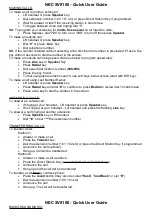
Charging the “Fireball 2001” Quad Rod
Non-Toxic Propylene Glycol Solar Loop*
NOTE: A CHARGING PUMP IS RECOMMENDED
Use the following method if one is not available and only when freezing weather is not a threat.
*Use non-toxic Propylene Glycol only, neve r use Ethylene Glycol (Antifreeze)
NOTE: You will need 2 Laundry hoses
(these can be "borrowed" from the washing machine).
Charging the solar loop is done through "Charging Valves", V1 and V2 using V3 to control flow:
This simple procedure uses gravity to fill (charge) the solar loop with Glycol.
V1, the Fill Valve is where water enters to fill the solar loop and “flush” the system after which the
glycol mixture enters by siphon from the "charging bucket" to fill the solar loop.
V3 acts as a block to force water and glycol up to the collector, through the entire loop and out V2.
When "Flushing" or "Charging" V3 is to be Closed, in operation V3 is to be Open.
V2, is called the Purge Valve because, when open, it allows water used to flush the system to exit
and purge air from the solar loop carrying any contaminants with it. When closed, after flushing
and no more air is in the loop, the system is pressurized through V1 allowing the loop fittings to be
checked for any leaks prior to charging the lo op with glycol. Glycol can then be charged into the
loop using a charging pump or the siphon method described here and out V2.
SIPHON LOOP CHARGING TECHNIQUE
(or use charging pump if available)
Connect a laundry hose to the Tank Drain and connect it to
V1. Close V3 and fill the solar loop with water through V1
and allow water to flow out a hose connected to V2 to flush
the solar loop. Close V2, allow pressure to build to 30
pounds, close V1 and check the system for leaks.
Keeping
the loop full of water,
disconnect the V1 hose from the
Tank Drain and insert it into the bottom of a 5 gallon
bucket with at least two gallons of a 50/50 mix of glycol
and water.
Fill the hose with water so no air is in it.
Elevate the bucket as high as possible.
It is important not
to get any air in the loop.
Open V2, have its hose drain to as low a point as possible
then open V1. Glycol should then flow into the loop.
Be
sure to not let any air into the system by preventing the
gallon container of glycol from fully emptying, add
water as needed.
When Glycol starts to flow out V2, Close
V2 then V1.
Reconnect the V1 laundry hose to the Tank Drain. Loosen
the connection at V1.
With V1 closed, slowly add water
until all air is out of the laundry hose, tighten the hose
onto V1 and with water still slowly flowing open V1.
Add water through V1 until the pressure gauge reads 28 –30 pounds, close V1. Be sure air vent cap at the top of
the solar loop is loose to let any air out of B1. Open V3 valve so solar loop is open to circulate.
Turn the pump on and check for circulation. If the sun is out, the solar return line should get hot. If the pump
sounds loud, air is probably in the system and it is “cavitating”. “Bump” the pump by turning it off and on until the
air leaves the pump. Check B1 again for any air and that the system is running quietly. Your system is “Charged.”
Call (888) 801-9060 if you have any problems charging the system.
V1
V3
V2
Pressure Guage
Air Release B1
Tank
Drain
Summary of Contents for Fireball 20014
Page 2: ......



































